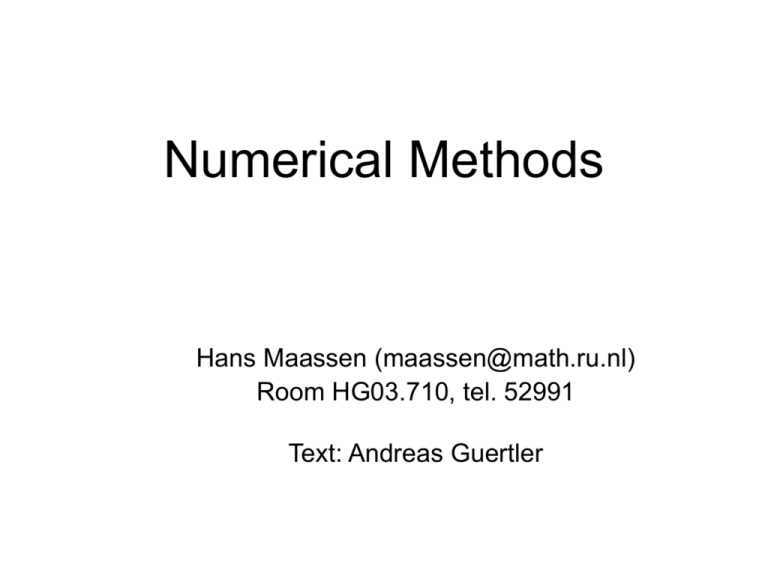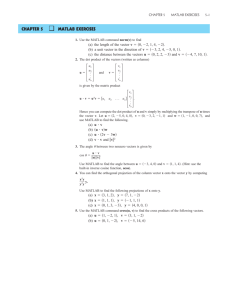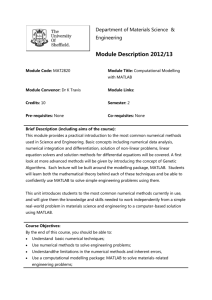Numerical Methods & Data Analysis 2005/2006
advertisement

Numerical Methods
Hans Maassen (maassen@math.ru.nl)
Room HG03.710, tel. 52991
Text: Andreas Guertler
Organizational Remarks
• First 2 exercises are to get to know Matlab
and are not graded
• other exercises together with one exam
for each part are needed for success
•Exercises on: www.math.ru.nl/~maassen/
Introduction
• Why do we need numerical methods?
• What are numerical methods?
• Programming languages
• Matlab: our choice for this course
• Introduction to MatLab
Why do we need numerical methods…
… if we can solve our problems analytically.
• What can we solve analytically?
– Harmonic oscillator (parabolic potential)
– 1/r potential two-body problem
(planet + sun, hydrogen atom)
– particle-in-a-box (box potential)
– and a few more
Why do we need numerical methods…
… if we can solve our problems analytically.
• What can we solve analytically?
– Harmonic oscillator (parabolic potential)
– 1/r potential two-body problem
(planet + sun, hydrogen atom)
– particle-in-a-box (box potential)
– and a few more
• What can’t we solve?
– All the rest!!!
All complex physical problems need numerics
OK, so we need a computer to calculate things,
but why so complicated?
• Even the simplest molecule (H2) can not be
solved completely yet.
We need efficient methods!
• Numerical programs calculate with finite
precision
We need to manage the errors
Numerical methods
• Numerical methods discretize and approximate
• In general, the precision is limited
• study of errors and their propagation is crucial
• often iterative methods are used (convergence!)
• Applications
– Evaluation of functions
– Interpolation
– Optimization
– Integration
– solving differential equations
Programming languages
• For every problem, there is a language:
– C, C++
– Java
– Fortran
• Numerical libraries
– Numerical recipes (http://www.nr.com/)
– NAG library
– LApack
• High-level development tools
– Mathematica, Maple
– IDL
– Matlab, Octave
Our choice for this course: Matlab
• Matlab: numerical development environment.
– Easy and fast programming
– data types (vectors, matrices, complex numbers)
– Complete functionality
– Powerful toolkits
– Campus license (from home: need Internet conn.)
• But: €xpensive!
• Alternatives:
– Matlab student license (without toolkits)
– Octave (free, Windows, Linux): www.octave.org
– SciLab (free, Windows, Linux): www.scilab.org
Plan for today
• Quick overview UNIX
• Introduction to Matlab syntax
• Concepts of Matlab (Variables, operators )
• a bit more advanced Matlab
(Vectors, matrices, plotting, loops etc)
• a few general points about numerics
• some tips and tricks
• During the first 2 courses: all commands written
in Courier can be typed in and tried
A few UNIX shell commands
• open command shell
• make new directory: mkdir NMDA
• change directory: cd NMDA
• show current path: pwd
• list directory: ls
• delete file: rm
• delete directory: rmdir
• copy, move file: cp, mv
• start program: type name (e.g. netscape)
• editor: e.g. xedit
Matlab startup
• Start Matlab:
– open console window
– type matlab
– without graphical interface: matlab –nojvm
• Online help:
– help keyword (e.g. help cos)
– doc keyword
– lookfor keyword
• make & change directory
–
–
–
–
mkdir ‘NMDA’
cd ‘NMDA’
pwd
ls
make new directory
change directory
print working directory
list directory
Matlab basics
• Variables are just assigned (no typedef needed)
a=42
s= 'test'
• basic operators ( + - * / \ ^)
5/2
ans = 2.5000
• functions (help
ans is a system variable
elfun)
sqrt(3), sin(pi), cos(0)
pi is a system variable
• display & clear variables
disp(a), disp('hello')
who, whos
clear a
clear
display value of a , “hello”
show all defined variables
clear variable a
clear all variables
• arrow up/down keys recall your last commands
Matlab examples
• Variables & Operators
a=5*(2/3)+3^2
a=2/4 + 4\2
;
a
• Elementary functions
result is shown
result is not shown
value of a is shown
overview: doc elfun
abs(-1), sqrt(2)
tan(0), cos(0), acos(1) …
exp(2), log(1), log10(1) …
• Rounding
•
round(2.3), round(2.5)
floor(5.7), floor(-1.2)
ceil (1.1), ceil(-2.7)
fix(1.7), fix (-2,7)
2
3
5
2
1
-2
-2
-2
• Complex numbers
(2+3i) * (1i)
norm(1+1i)
-3+2i
1.4142
towards smaller
towards larger
towards 0
Vectors
Matlab’s greatest power
Vectors
• Row and column vectors:
[1, 2, 3] → (1 2 3)
[1; 2; 3] → ( 1
alternative: [1 2 3]
2
3 )
[1
2
3]
• Initialize a vector: [start : end] or [start : step : end]
[1:5]
[1:3:10]
[0.5: -0.5 : -0.6]
(1 2 3 4 5)
(1 4 7 10)
(0.5 0 -0.5)
• linearly and log-spaced vectors with N elements
v=linspace(0,1,4)
w=logspace(1,4,4)
( 0 1/3 2/3 1 )
(10 100 1000 10000)
• Set or display an element
v(4)
w(3)=99
1
10 100 99 10000
element #4
change element #3
Working with vectors
• Address elements of vector
v([1,3,5])
v([2:4])
v=[1,4,9,16,25]
(1 9 25)
(4 9 16)
elements 1,3,5
elements 2,3,4
• Set elements of a vector
v([1,3,5])=0
v([1,3,5])=[1 2 3]
v([1,3,5])=[1 2]
(0 4 0 16 0)
(1 4 2 16 3)
ERROR
set elements 1,3,5 to 0
set el. 1,3,5 to [1 2 3]
Vector dim. must agree!
• Find and replace elements v=[1,4,9,16,25]
p=find(v>8)
v(p)
v(p)=0
(3 4 5)
(9 16 25)
(1 4 0 0 0 )
• Simple arithmetics with vectors:
indices of elements >8
elements >8
set elements >8 to 0
[1 2 3] + [4 5 6]
[1 2 3] + 4
[1 2 3] * 2
(5 7 9)
(5 6 7)
(2 4 6)
[1 2].*[3 4]
[1 2 3] .^2
1./w, .^
(3 8)
(1 4 9 )
• Element-wise operations : v.*v,
More vector operations
• Transpose vector v: v’
v.’
• Inner product: v*v’
[1 2]*[3 4]’
(complex conjugate transpose)
(normal transpose)
(check what v’*v gives!)
11
• cross product for 3-dim vectors:
cross(v,w)
• Functions of vectors v=[1,4,9,16,25]
sqrt(v)
sin([0:0.1:2*pi])
(1 2 3 4 5)
• Sum, product of elements
sum(v),
prod(v)
• Euclidian norm of a vector
norm(v)
• Number of elements
length(v)
sqrt(sum(abs(v).^2))
Plotting vectors
• y-plots
1
y=sin([0:0.1:2*pi])
0.5
plot(y)
0
-0.5
• xy-plots
-1
0
x=[0:0.1:2*pi]
y=sin(x)
plot (x,y)
20
40
60
2
4
6
2
4
6
1
y could be matrix as well!
• plot formats
0.5
0
-0.5
y1=sin(x)
y2=cos(x)
-1
plot (x,y1,’o’,x,y2,’+’) see help plot 0
1
• lin-log and log-log plots
semilogx,semilogy,loglog see help
0.5
0
• Axes, labels
axis, xlabel, ylabel
-0.5
see help
-1
0
Flow control
• conditional execution (if/then)
• loops (for, while)
comparisons and conditional execution
• relational operators
<, > , <= , >=
== , ~=
less, greater, less-equal, greater-equal
equal, not equal (caution: equal is not = )!
• Logical operators
&, | , ~
(2>5) & (1>0)
(0>0) | (1>=1)
~(1>1)
~(10<=9) & ~(1>0)
and, or, not
• simple if:
if (condition); … ; end
if (rem(x,3)==0)
rem gives remainder of a division
disp(‘number is divisible by 3’)
end
• if-else:
if (condition); … ; else … ; end
if (rem(x,2)==0)
disp(‘number is even’)
else
disp(‘number is odd’)
end
flow control: loops
• for loops: perform a loop for every element of a vector
for variable=vector; … ; end
fib([1 2])=1
calculate the first 10 Fibonacci numbers
for i=3:10
fib(i)=fib(i-1)+fib(i-2)
end
• while loops: perform a loop while a condition is “true”
while (condition); … ; end
fib([1 2])=1
calculate the first 10 Fibonacci numbers
i=3
while (i<=10)
fib(i)=fib(i-1)+fib(i-2)
i=i+1
end
Matrices
• Generalized vectors
• Most vector functions work on
matrices, too
Matrices: the general case of vectors
• Initialize a matrix:
[1,2,3; 4,5,6; 7,8,9]
gives
1 2 3
4 5 6
7 8 9
gives
1 4 7
11 14 17
21 24 27
• we can play all the vector tricks
M=[1:3:9; 11:3:19; 21:3:29]
• Access matrix elements: M(row,col)
M(2,3)
M(1,:)
M(:,2)
17
1 4
4
14
24
7
access single element
access row vector
access column vector
M(2:3,1:2)
• special matrices
ones(2) ones(2,3) eye(2)
1 1
1 1
1 1 1
1 1 1
1 0
0 1
• find,replace matrix elements matching an expression
find (M>15)
M(find(M>15))=-1
Matrix operations
• Matrix product: A*B
number of columns in A must be
number of rows in B
• element wise product: A.*B
• left/right division:
A/B = ((B’)-1*A’)’
A\B = A-1*B
•
•
•
•
•
calculation is done without
calculating A-1 => more efficient
inverse matrix: inv(A)
determinant: det(A)
Eigenvalues: eig(A) A should be square
create a diagonal matrix: A=diag(v)
size of a matrix: size(A)
Input/Output
• printing text and variables to the screen
• reading from/ writing to a file
formatted text
• to output data (to screen or to a file) we need a way to
•
•
control the format of numbers
fprintf (format-string,var1,var2,var3…) does just that
the format string defines how variables are printed.
Example 1:
a=1; b=2.65;c=12345;d='test'
fprintf ('%d %f %e %s \n',a,b,c,d)
1 2.650000 1.234500e+04 test
Example 2:
fprintf (‘a:%2d b:%1.2f c:%1.4e \n',a,b,c)
a: 1 b:2.65 c:1.2345e+04
saving & loading data
• variables can be saved to binary and text files
• save and load the complete workspace (binary)
save filename, load filename
• save & load variables to/from file ' test.mat'
save 'test' a b c; load 'test'
• reading a formatted data file
[A,B,C,...] = textread('filename','format')
example file:
1.2
5.5
1
3.3
6.6
2
4.4
7.7
3
[A,B,C]=textread(‘test.dat', '%f %f %f')
A=
1.2000
5.5000
1.0000
• general data input/output
f=fopen('filename')
fprintf (f,format, v1,…)
fscanf (f,format, v1,…)
fclose(f)
open file
formatted output to file
formatted reading from file
close file
m-files
• Matlab commands can be put in a textfile
with ending .m
• .m files can be edited with the Matlab Java editor or
any other text editor (e.g. xedit)
• if the file example.m is in the current directory
(pwd, cd) or in the load path, it can be called by
typing example
• Modifying the load path: path,
addpath
• Modular programming: function .m-files
function definitions
• A function is a name for a particular calculation or
•
•
subroutine. It can be called be that name, can take
arguments and return a value
It must be put in a .m-file with same name as function
Define function:
function returnvariable=name(arguments) … end
in separate file square.m:
function ret=square(n)
% calculate n^2
ret=n*n;
end
• square(3)
help (square)
ans=9
Example: print number in binary system
file binary.m:
function b=binary(num)
% return num in binary format as string
b='';
x=num;
while (x>0) | (strcmp(b,''))
if rem(x,2)==0 b=['0' b];
else b=['1' b];
end
x=fix(x/2);
end
end
file example.m
n=input('Please enter a number:');
disp(binary(n));
Exercise now: convert binary to decimal
• Now, write a function which takes a binary number in
string bin and converts it to a number
• hints:
– you can use a for or a while loop
– access ith character of a string s with s(i):
s='test';
s(3)
's'
• For cracks: Do the binary-to-number conversion in
one line, without loop!
hint: Use all the vector tricks,
Use s-48
Solution
function r=bintonum(s)
% takes binary number s as string,returns integer
n=0;
i=length(s)-1;
for (c=s)
n=n+str2num(c)*2^i;
i=i-1;
end
r=n
end
One-liner: (much faster!!!)
r=sum((s-48).*2.^[length(s)-1:-1:0])





